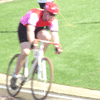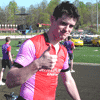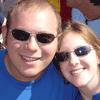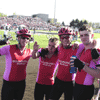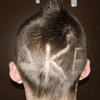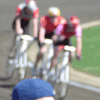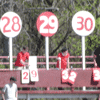|
Delta Psi fields its first team in I.U.'s Little 500 Bike Race
The 55th running of Indiana University’s Little 500, modeled after the Indianapolis 500, is a famed tradition and the hallmark of "The World's Greatest College Weekend." Teams must qualify successfully with appropriate hand-offs, and only the top 33 out of all entries are included. Teams must be comprised of IU students, and the event is run by the Indiana University Student Foundation, a group awarding significant scholarships to students
Composed of two races, this year the Women's Little 500 was held Friday April 15, and the Men's Little 500, featuring the first Deke team to participate on the I.U. course, took place Saturday, April 16.
Female riders joined the celebration in 1987 and the four-women teams travel 100 laps total, or 25 miles. Male cyclists began the tradition in 1951 and cycle the track 200 times, or 50 miles, with a four-man squad.
This year, the Teter Women, representing the residence hall in central campus, were the victors, with Kappa Alpha Theta in second, followed by Kappa Kappa Gamma in third.
As the Teter women took control with a near half-lap victory in 2005, this year's Men's race was extremely tight until the finish. In a final sprint on lap 199, Dodds House, a residence hall team, edged out Phi Gamma Delta to become the 55th Men's Champion.
The rules on the bicycle track are nearly identical to those at the Indianapolis Brickyard, down to the traditional checkered flag, Indy pace car, and the singing of "Back Home Again in Indiana." After a balloon release and the call to "mount your Schwinn bicycles," all riders are led by a pace car for three laps. At the green flag, cyclists jockey for position and continue around the track, exchanging bikes and riders within the team as the race progresses. Top women's times are usually just under 70 minutes for 100 laps, while men finish just above 2 hours for 200 laps.
Deke alumnus Nathan Hartman '02, was the first IU student to ride with any membership associated with Delta Kappa Epsilon. As DKE did not have a team until this year, Nathan rode his junior year in 2001 for Briscoe Hall. That same spring, Nathan was honored as Rookie of the Year, and his Briscoe squad placed 16th overall.
DKE made its first qualifying attempt the following spring, 2002. With only three riders that afternoon, instead of the traditional four, the fraternity did not succeed as one of the top 33 teams. Two years passed without making another attempt, as Deke did not have a strong focus on cycling with its off- campus status. A renewed energy for riding came about this fall, with Scott Shtofman ‘06 taking the helm as team captain. Though unable to ride in the event, Scott started this year's new riders on a training program, including a spring break trip for two rookie Dekes.
March 26, 2005, saw the first-ever Delta Kappa Epsilon cycling team qualify for the race. All four members of the team were rookie riders, including Tony Willemin '07; Dustin Parrish '07; Kevin Corrigan '08; and Cameron Wallace '08. The field for the 55th Little 500 was set with DKE officially on the scoreboard in the 28th qualifying position. Having only trained for six weeks prior to the race, this was an outstanding accomplishment. Most teams train year-round, and almost none are composed entirely of rookie athletes.
Once entered into the field, teams are given sponsors from the Student Foundation and jerseys are selected in the order of qualification. DKE landed the red and pink tops, with DeFeet as its corporate sponsor, a custom designer of athletic socks. The sponsoring organization does not contribute financially to the team itself; it merely puts its name on the team's jersey as a means of advertisement and gives charitable donations to the Student Foundation.
The most critical component of the qualifications is the exchange between each rider. As the Indianapolis 500 has drivers race for their fastest four-lap average, the Little 500 has each man travel one lap and make an exchange to complete a 4-lap circuit as fast as possible. Riders of varying heights and weights must adjust throughout these changes. DKE used two separate bicycles to facilitate this effort as the riders threw the reigns to one another throughout the course. Each team is allowed a max. of two bikes, and most often, they are each used to fit particular members of the team.
As exchanges are made, one rider may simply touch the other, who is stationed in the pit on a separate bike; or, as one rider comes in for a stop, he leaps off the current bike and passes it along to the next man who is standing ready to jump on.
The Deke team exchanges were executed well within the race, and quickness kept the team among the pack for much of the first half. Endurance training was the team’s weakest aspect, and as the laps increased, so too did DKE's strength.
Deke’s final placing put it 32nd in the field, but “the entire chapter could not be prouder,” said president Kevin Cane ’05. “The stands were filled with hoards of fans wearing "DKE Cycling" T-shirts of royal blue, and chants of "D-K-E" echoed from our second turn pit toward the press box. Brothers, pledges, parents, girlfriends, Greek neighbors, and other supporters shouted for our team, with many of the brothers shaving their heads in honor of the first team,” he said. The completion of the race saw Dekes lingering as one of the final teams to leave the stadium--soaking in the excitement from the fraternity's first entry in its five-year history.
Next year's team begins training in weeks. “The jump-start for 2006 begins now, and interest within the chapter has grown significantly,” Kane said. “All four riders from this spring will return, and there is a likely pick-up of 2-3 additional brothers, who intend to begin their own rookie training. With a fleet of as many as seven cyclists, training will become increasingly competitive, and the top four riders really will be earning their spots for a chance at the 56th Little 500 in 2006.”
Delta Kappa Epsilon is a social fraternity founded at Yale University in 1844. More than 70,000 men have been initiated into DKE, including newspaperman William Randolph Hearst, financier J.P. Morgan, Senate Majority Leader Henry Cabot Lodge, Yankees’ owner George Steinbrenner, Composer Cole Porter, Chase Manhattan’s Irving Chase, Proctor and Gamble’s James Gamble, and the Wrigley Company’s William Wrigley. Four current U.S. congressmen and four current state governors are members of the fraternity, as are five presidents of the United States. Rutherford Hayes, Theodore Roosevelt, Gerald Ford, George H.W. Bush, and George W. Bush have been active members. |

